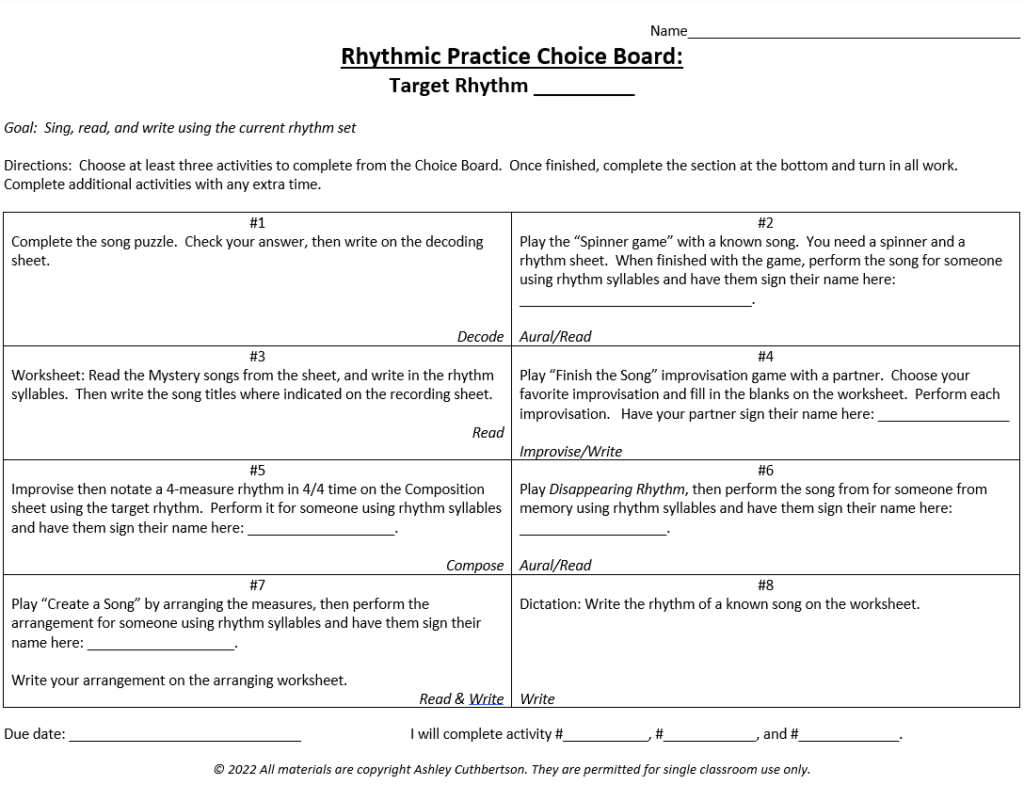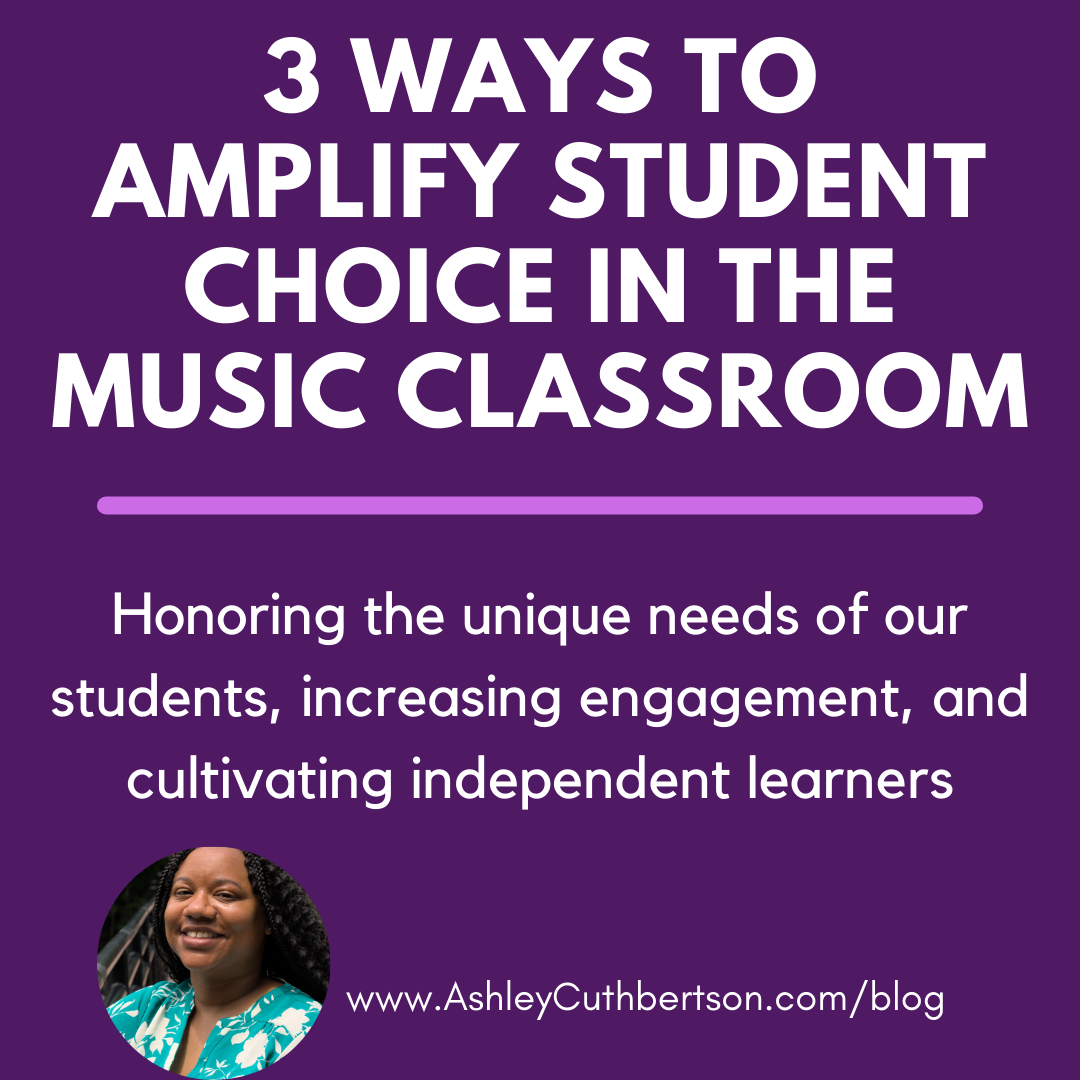Listen to this blog post by clicking the audio player below!
An important part of fostering a learner centered, culturally responsive learning environment is intentionally making space for students to make choices about their learning. Not only does student choice improve engagement, but by making space for student choices, teachers are honoring the unique needs of students and supporting them to become independent learners.
What is student choice?
Student choice occurs when teachers make space for students to make decisions about their learning.
Student choice can look a variety of ways in the music classroom, including choice over learning path, pace, place, musical content, and performance medium.
One important thing to keep in mind about student choice is that students will need support and guidance with making choices, especially if they are used to a more teacher-directed approach.
Our traditional schooling models emphasize student compliance and “getting the right answer.” In guiding students to make choices, it’s important to emphasize that part of the process is trying different things to see which choice will help them best understand, not necessarily which choice gets them to the right answer right away. Teachers can support this process by modeling, providing fewer choices to choose from to start, and by providing clear learning goals.
Let’s take a look at three ways to amplify student choice in the music room! And stay tuned for a free resource download!
#1: Choice of Performance Medium
Just as artists work in different mediums, such as paint, watercolor, metal, or digital media, musicians also work in different mediums. Musicians engage in singing, instrument playing, movement, and digital music tools. Each medium is important to develop, however we all have our own preferences as to how we prefer to perform.
With students, we can make space for them to choose their own performance medium when the learning goal is not directly tied to a specific medium.
Here’s an example:
Learning goal: Students will decode a melody in do pentatonic.
Here, the students are practicing the skill of decoding melodies. They can use singing to demonstrate their understanding by singing the solfa pitches, or they could use instruments such as pitched percussion or recorder, or they could use a digital musical tool such as Google Chrome Music Lab’s Song Maker to visually decode the song. Either way, students are all still working towards the same goal.
#2: Choice of Content
When we think creatively and focus more on being a facilitator rather than a “sage on the stage,” we can explore new ways for amplifying student choice while also focusing on developing musical skills.
Giving students choice of musical content opens up so many choices to students and can greatly increase their engagement levels. When teachers are clear about the learning objectives, we can see that there are numerous ways to give students choice over the content they use to learn these objectives, especially with older students (upper elementary, secondary).
Here’s an example:
Learning objective: Students will analyze musical form.
With my upper elementary students, one of my favorite units has been a Project Based Learning (PBL) unit I typically do in the spring where students work in small groups to select a musical piece, then create movement choreography to demonstrate the form.
In the whole group portions of our lessons, we practice analyzing a variety of types of forms and engage in a variety of movement activities (folk dance, body percussion, props, etc) so that when it’s their turn to analyze the form and create movement for the pieces they have selected they have the background knowledge and practice to do so.
Not only do students have lots of space for choice in this unit, but they are also developing their independence as they transfer their understanding from one context (our whole group lessons) to another context (the piece they select).
#3: Choice of Learning Path
Learners all bring with them background knowledge, interests, and varying levels of understanding. Allowing students to have choice over their own learning path during a lesson or unit of study allows them to make decisions about what they need to reach goals. This also leads to students having greater ownership over their learning and thus better command over understanding.
One of my favorite ways to make space for student choice is utilizing choice boards or learning menus. It does take some work on the front end to gather resources and get organized, however once it’s done, you can reuse them over and over again!
Here’s an example:
Learning goal: Students will aurally identify, read, and write using the current rhythm set.

I use this choice board when I’m working on a long-term unit like a particular rhythmic or melodic concept. I created it specifically to be easily applicable to any rhythmic concept unit so I can easily reuse it.
In the whole group portions of our lessons, we’ll progress through a variety of skills (decoding, reading, writing, improvising, composing, etc), however during practice time students can choose where in the skill sequence they’d like to work.
Click here for a free download of this choice board!
Student Choice: An important Part of a Culturally Responsive Music Classroom
Culturally responsive music educators know that creating a learning environment that respects and honors students’ backgrounds and funds of knowledge means that we also have to make ample room for students to make choices about their learning so that they may cultivate the skills needed to become independent learners.
How do you make space for student choice?
I would love to know how you make space for student choice in your lessons! Comment below or share on social media and tag me: I’m @ACuthbertson10 on Twitter, Instagram, and Facebook.
Also, let me know what you think of this post! If you haven’t already, be sure to sign up for my weekly email newsletter where I’ll be sending these blog posts each week, as well as other music ed resources and tips.
Until next time,
Ashley
P.S. Don’t forget to grab your copy of my Rhythmic Choice Board, it’s free!
Connect with me!
